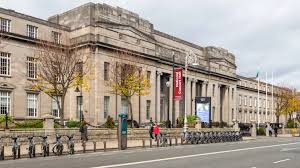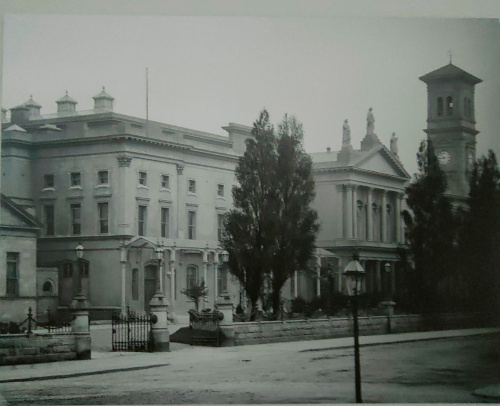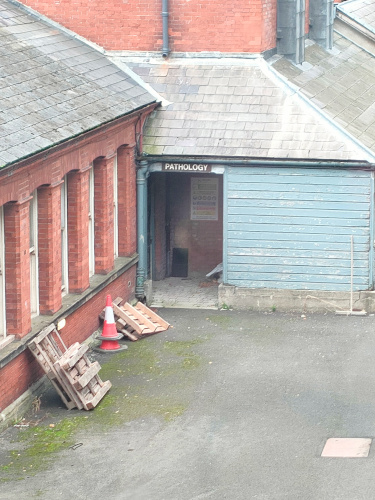The joy of doing gig work in the performing arts means that sometimes you are in non-public facing areas of interesting places. Now, I am someone who likes both history and architecture, so it’s not always hard to find something I’d consider interesting, but the specific quality of hidden or forgotten parts of a place that only exist once you’re past the ‘Employee Only’ door are always unexpected and sometimes truly bizarre. I know when I worked in the box office of a theatre in Boston I’d find abandoned safes, decades-old and abandoned merch, and we had a collection of several hundred CDs collected over the years. If I looked hard enough, I’d also find tape cassettes and inside jokes from dead actors scrawled on the walls.
This week I am in and out of Ireland’s National Concert Hall in Dublin. I had actually attended concerts here prior to my ever going ‘backstage.’ But this building has only loosely abandoned its earlier uses. Let’s take a brief photo journey through some NCH history.
The first image is a modern picture of the National Concert Hall from the street.

This next image is one that’s posted in the upstairs hallway of an earlier life of the building. The accompanying caption reads: The Royal University Dublin pre-1908. During major University College Dublin reconstruction work, the campanile was dismantled and removed to the Royal College of Science in Dublin’s Merrion Street around 1915.

That’s right! The NCH used to be one of the buildings for University College Dublin (one of the Irish state schools, along with others like UC Cork and UC Limerick) back when all of the Dublin universities were downtown. It makes sense that a state-owned building would remain a state building when UCD moved to their Belfield-area campus in the 1970s. According to wikipedia, the building was originally an exhibition hall until it was repurposed into a university in the late 19th century, so going from university to concert hall is hardly its first rebranding.
Just being an old school building or exhibition hall isn’t particularly fancy, as any number of buildings are abandoned schools, or churches, or supermarkets. It’s probably more common for a building to have had multiple uses throughout its life than to remain one single entity forever. The Boston theatre mentioned previously had been a church in its past, for example. But like so many areas of downtown Dublin, there were important connections to the Irish civil war too.

The caption accompanying this picture states: Council Chamber of UCD, now the Kevin Barry Room, where the Treaty debates took place between 14th December 1921 and 10th January 1922. On the reverse of this photograph, it was noted at the time ‘would not be allowed take photo during sitting.’ There are actually quite a few photos on the walls of civil war and independence relevant images and details, and so even wandering the halls can be an interesting experience. But notice the benches in that photo of the Council Chamber?

Those benches are still here! This is one end of the first floor hallway, each of these rooms are currently small rehearsal spaces and lesson rooms. They could of course be repro, but they are such an unusual shape I feel like it would be easier to just re-use old benches rather than source a modern recreation. It does look like some of the hardware has been changed, but the overall appearance is the same.
I have, however, saved the best secret for last. Any building can have a past. Any building can reuse furnishings from said past. But let’s take a peek out the windows of that hallway with all of the benches.

See it yet?

A pathology lab! This UCD building had been where medicine and engineering studied and these traces are absolutely everywhere that concert patrons are not. Many of the rehearsal rooms and offices are labeled as the offices of former professors or different departments or specific classes. As many of these doors are starting to lose some of their letters, and I was technically working, I only snapped one quick photo of a particularly nice example of this.

Isn’t that just so charming? I love how the professors and students stepped out of this building one day and the building has waited for their return. As the main concert hall only opened in 1981, a friend of mine said his father had attended UCD when it was here, and that the concert hall was the exam room. It had apparently made for a nervewracking first concert experience, trying to overcome the training of four years worth of fear and stress that lurked behind the doors to that room.
What history is hidden in the buildings you frequent? Even the simplest thing gains shine when viewed from decades away, and it is often a fun game to try and find the evidence of the past.
If you like the content of this blog, please share it around. If you like the blog and you have the means, please consider joining my lovely patrons in paying for the work that goes into it. Due to my immigration status, I’m currently prohibited from conventional wage labor, so for the next couple years at least this is going to be my only source of income. You can sign up for as little as $1 per month (though more is obviously welcome), to help us make ends meet – every little bit counts!
